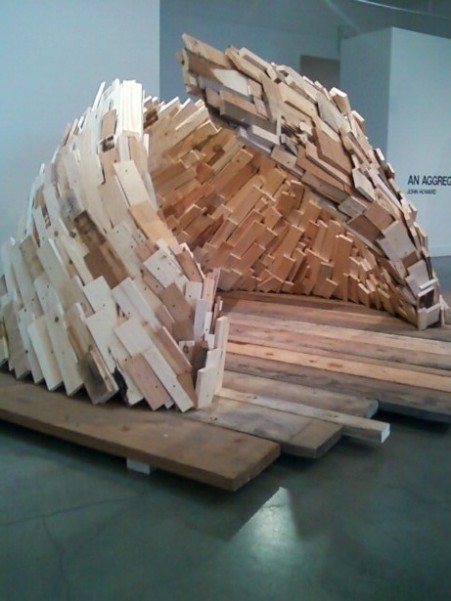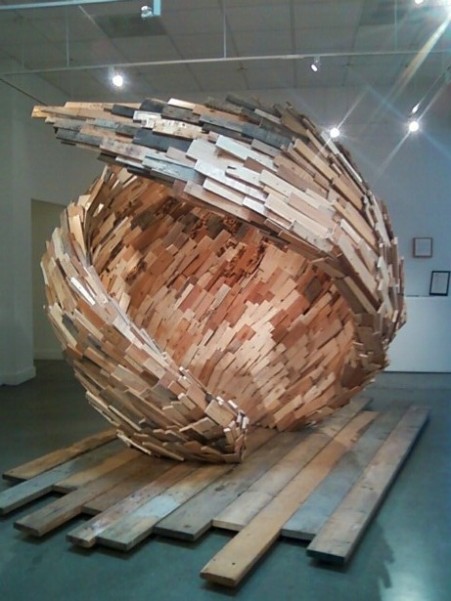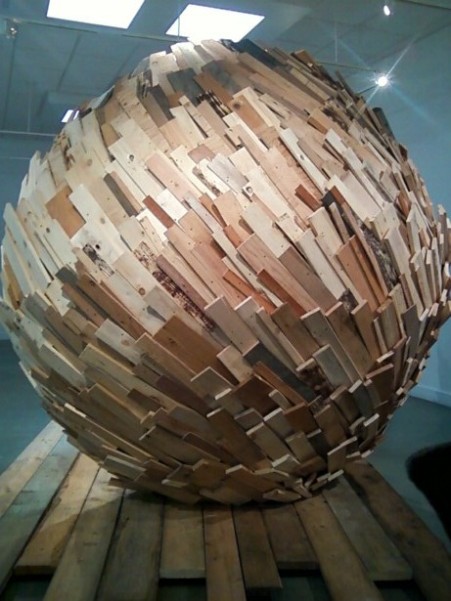Aggregate: \a-gri-gət\ noun:
A mass or body of units or parts somewhat loosely associated with one another -Merriam-Webster Dictionary
John Howard’s An Aggregate consists of two wooden sculptures displaying the power and potential of living together in a strong community. The wood structures reflect the communal actions of herring fish when in danger. The sculptures are created out of hundreds if not thousands of individual pieces of wood. When singled out, a lone piece of wood is weak and insignificant, but when united and formed together these weak pieces become a powerful body. The individual pieces now support each other, and their unification makes something beautiful that cannot be easily brought down. Howard’s intention with An Aggregate is to reveal how society today is lacking strength due to its emphasis on individualism rather than community. If society would mimic the actions of humble fish, it could create something strong and beautiful as well.
The larger sculpture is placed in the center of the gallery floor. It is a massive sphere that opens in the back with elegant curves. It is looming and powerful, displaying strength and grace. The open-ended sphere seems alive with the alignment of the pieces of wood that create its structure. It is reflecting a captured instant of the fish’s movement that it is modeled after. Howard’s composition can be compared to that of a photographer capturing an image of a dancer in the middle of a sweeping move. It displays the graceful lines and composure the fish have when moving together. The different kinds of wood harmonize,creating a lyrical movement that breaths life into the sculpture. It stands tall and proud, expanding its sides and taking up the right amount of space to show off its almost perfect spherical shape. It is dramatic and strong, looking as if it may continue working its way up and begin swimming through the air.
When one steps into the middle of the massive structure, one feels caught up in a protective embrace. The wood swirls around and up, surrounding the person who is in the middle. Viewers feel as if they are being swept up into the wave. They become part of the fluid movement.
The smaller sculpture has a similarly fluid movement. It is, however, more grounded than the larger piece, which looks so buoyant. Its larger base and triangular shape make it look constricted, especially when compared to the large piece, which is shameless in the amount of space it consumes.
This leads to an equally important aspect of the show. With only two pieces making up An Aggregate, a significant amount of the shows appeal relies on the use of the gallery space. Visitors coming in from the front door immediately see the smaller of the sculptures, and then they are exposed to a huge wooden bubble. The bubble, of course, is just the other side of the large sculpture, but the front of the piece is such a strong part of the show that perhaps it should not have been hidden from immediate sight. Introducing visitors to the back of the large structure makes the piece look closed-off. The front successfully uses the negative space surrounding the sculpture to create powerful movement, giving the sculpture life. The back view feels as if it is excluding the audience from what is inside. The smaller piece also feels awkwardly situated. The opening faces more towards the wall than toward the center of the gallery. Perhaps the show would have seemed more cohesive had the internal space of the sculptures been more successfully combined with the larger gallery space.
Howard’s sculptures are beautiful representations of the strength that lies in relying on one another. Howard sees potential for human community and uses An Aggregate to share the strength and beauty that would be possible if we were willing to be humble and sacrifice our desperate need for individualism in order to protect those around us.
Victoriana Dan









